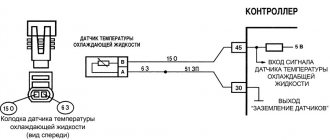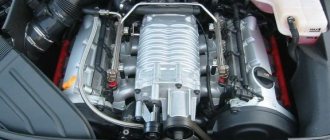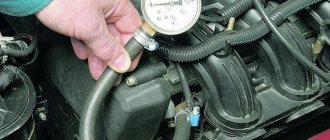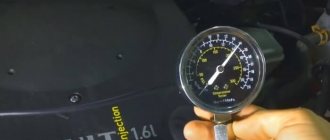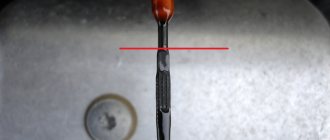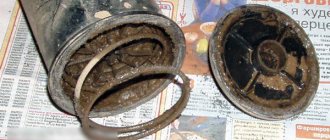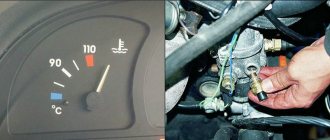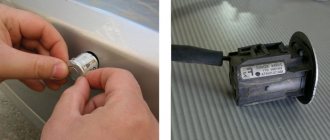Checking the coolant temperature sensor (CTS) is a work aimed at determining the performance of the unit and its ability to respond to changes in temperature conditions.
To complete the work, you can go in two ways: immediately dismantle the device or first carry out a check without removal.
When choosing the first option, you will need a regular wrench of the required size (usually “19”), but on some foreign cars - a 20, 21 or 22 socket.
First make sure that the DTOZh receives a voltage of 5V (from 5 to 12 on some models). If it fits, you can proceed with the rest of the test.
Below we will consider in detail all the diagnostic methods, the causes of sensor failure, features of its location and other features using the example of VAZ cars with 8 and 16 valves, Kalina, Gazelle, 2115, 2114, Renault Logan, Lada Priora and Chevrolet Niva. The methods described below are also suitable for most other brands of cars.
Design and principle of operation
The DTOZh temperature sensor is a resistor (thermistor) that reacts to the temperature of the antifreeze in the engine cooling system. Information about the resistance of this element is transmitted to the ECU, which decides to change the settings in the engine operation.
The information obtained is used by the ECU to determine the steps of the idle speed regulator to optimally adjust the required volume of the fuel mixture.
The peculiarity of DTOZH is that in the cold its resistance increases, and when heated, on the contrary, it decreases.
So, when reaching 130 degrees Celsius, the resistance parameter is 70 Ohms, and at minus 40 degrees - 100.7 kOhms.
The thermistor is controlled by applying +5 V voltage to it from the controller.
The potential passes through a classical resistor with constant resistance (R).
The antifreeze heating level is calculated based on the voltage drop across the DTOZh with variable R (Ohm). In this case, the drop will be large on a cold engine, and low on a warm engine.
What does it affect?
Due to the signals sent by this small element, the ECU generates control commands to a huge number of actuators. So, if the unit receives information that the coolant temperature is cold, the system recalculates the fuel injection time into the cylinders upward.
This increases the stability of the engine in idle mode. But during the warm-up process, the engine temperature rises, which means the ECU will begin to lean the fuel mixture. E
- If there are signs of a malfunction of the coolant temperature sensor, the ECU may receive erroneous information and the mixture will be excessively rich.
- In addition to the fact that this significantly increases fuel consumption, the atmosphere is also heavily polluted.
- The spark plugs quickly become covered with black dry carbon and may fail. The engine may stop if the number of revolutions at the time of starting is insufficient.
- A floating command from the ECU to increase the speed so that the engine does not stall will help get rid of this.
- To maintain controllability during startup, the recirculation valve must be kept closed.
And so on until the system reaches operating temperatures. If there are signs of a malfunction of the coolant temperature sensor, then as a result the engine will operate unstably and the speed will fluctuate.
There is a risk of the engine stopping. The ignition angle also depends on whether the DTOZ functions normally. The system regulates this parameter according to certain regulations. This will reduce harmful emissions before the engine reaches operating temperatures. The level of fuel consumption, engine power and thrust also depend on ignition.
The carbon filter, which catches fuel vapors, will only be purged after the power unit has completely warmed up.
The torque converter clutch in an automatic transmission does not lock until the engine is fully warmed up. This is done to maintain optimal handling.
The sensor also ensures that the vehicle's cooling system fan starts. Due to additional fan cooling, the liquid will cool down much faster. In some vehicles, a separate sensor is used to start forced cooling. But where it is not there, its tasks are performed by the DTOZH.
Where is
To check the DTOZH, you need to know its location. Please note that the location of the sensor may vary depending on the make/model of the machine.
Most often, the thermistor is mounted between the cylinder head and the thermostat or on the coolant outlet pipe.
But on some cars it is installed on the radiator pipe.
Externally, the device looks like a small element with a thread, with which the DTOZH is screwed into a special hole. In this case, the regulating element itself is located in the antifreeze and controls its temperature.
In certain cars, for example, the BMW E39, there may be two DTOZH. One controls the heating of the antifreeze and is installed at the outlet of the engine, and the second is located behind the radiator. To remove you will need a 22 key.
This type of installation allows you to control the temperature in different areas and thereby take action faster.
Note that two sensors are installed on powerful / expensive cars, where the temperature parameter is of key importance.
In this case, the control unit must have appropriate programs. For more information, please refer to your vehicle's manual.
Functionally, the sensor is very reliable and breaks down in rare cases. Most often it shows false information. Sometimes other damage is possible, for example, chafing of wires or poor contact quality.
As for the features of the location of the DTOZH on different models, we will dwell on this issue below.
How to replace a temperature sensor
To replace the coolant sensor, you will need the following tools:
- Keys at 8, 13, 17 and 21;
- Water container;
- 5 or 10 liters of antifreeze.
Regardless of the make and model of the vehicle, the removal and installation of the coolant sensor is generally carried out according to a similar algorithm:
- We turn off the car engine and let it cool. This condition is, first of all, mandatory from a safety point of view. Firstly, a cold motor will eliminate the possibility of burns. Secondly, cooled antifreeze is much easier to drain from the cooling system.
- At the next stage, remove the air filter and disconnect all the sensor power wires.
- Carefully drain the coolant into a container prepared in advance.
- We unscrew the DTOZH from its socket.
- Due to the design features of the measuring device, its repair is irrational or impossible. A more optimal solution in this case is to install a new sensor.
- Before screwing in the new sensor, it is recommended to apply sealant to its threads. The device is connected back to the electrical network;
- Antifreeze is poured into the cooling system. Depending on whether the coolant was completely or partially drained, you will need to fill in from 5 to 10 liters.
- Upon completion of all work, it is necessary to check the quality of operation of the new sensor and the appearance of antifreeze leaks. To do this, just start the engine for a few minutes.
As a rule, the process of replacing DTOZH does not cause any special problems or questions. Even novice drivers can cope with this task in their own garage.
The coolant temperature sensor of a VAZ or any other car is a small but very important part that ensures trouble-free and efficient operation of the internal combustion engine forced cooling system. If the DTOZ fails, the power unit may overheat, and this in turn can result in serious consequences. Therefore, at the first sign of a malfunction of the thermistor that measures the temperature of the motor, it is necessary to eliminate the breakdown as soon as possible. To check the sensor, it is enough to have a multimeter, thermometer or personal diagnostic scanner on hand.
Symptoms of a problem
To take measures to control the coolant temperature sensor, it is necessary to identify problems in this unit in time.
But it is worth considering that the signs discussed below may indicate other malfunctions of the power unit.
This is why additional diagnostics may be required to obtain an accurate result.
It is also important to understand what part the DTOZH takes in the operation of the engine:
- Informs the driver in real time about the coolant temperature.
- When the engine reaches a threshold temperature value, the ECU, having received information from the coolant sensor, turns on the forced cooling fan, as a rule, this is about 100 0C.
- Participates in the process of increasing idle speed by enriching the fuel-air mixture on a cold engine.
- When the car is moving, the ECU generates general information about the operation of all systems based on the data received from the sensors and, based on this data, forms the correct fuel-air mixture. The coolant temperature sensor also takes part in this process.
Primary symptoms of failure:
- The Check Engine light on the dashboard comes on. To obtain more accurate information, it is better to scan the ECU and look for errors, for example, through an ELM327 auto scanner connected to a smartphone. See error codes below.
- The engine starts and immediately stalls.
- Malfunction of the fan in the radiator. The malfunction may manifest itself as a refusal to turn on when it heats up or operation even after the motor has cooled down. When the DTOZ is turned off, the electronic control unit of the machine perceives the problem as a break and turns on the fan.
- The appearance of dark or gray-black smoke from the exhaust pipe.
- Increased "gluttony" of the car. This is due to the fact that incorrect information is supplied to the ECU. Accordingly, the “brains” of the machine cannot determine the volume of displacement required to maintain optimal temperature conditions.
- Antifreeze leaking from under the DTOZh housing. This problem can be determined by visual inspection.
- A hot engine stalls. The problem may occur when the maximum temperature is reached. In this case, the type of coolant filled does not matter.
- The power unit heating indicator on the dashboard does not work.
- Engine malfunctions. The problem may manifest itself as stopping at low speeds, difficulties starting in winter, hesitation when operating at idle, etc.
- The coolant boils, but the instrument panel displays the temperature within normal limits.
- Increased engine heating time, etc.
The problems discussed above can occur one at a time or in combination, but in most cases they indicate a malfunction of the power unit. However, the antifreeze temperature sensor is not always the main cause of the malfunction.
Incorrect operation of the DTOZH. Guidelines for the driver.
The simplicity of the device guarantees its long service life. But sometimes it fails. If the sensor is broken, it must be replaced. This is a consumable item and cannot be repaired. However, the vast majority of failures are related to electrical circuit integrity. Breaks, waste contacts, rust and dirt are the main triggers for opening the circuit. It is precisely these problems that every car enthusiast can identify and fix himself.
The device does not break down instantly; shortly before “death” it sends distress signals, which the driver must be able to recognize. Among them:
- The fan does not turn on. This, of course, is not the main symptom, however, the very first alarm bell;
- Increased gasoline consumption;
- Idle speed too high;
- Characteristic sounds of engine detonation;
- Difficulty starting;
- Increased heating of the motor, up to absolute overheating;
- Error message from the on-board computer.
Among the many reasons for device failure, we highlight the most important:
- Poor quality coolant. Leads to the coating of the surface of the sensitive element with crystalline sediment, and also destroys the surface of the sensor;
- Leakage and decrease in antifreeze level. The cause is a worn gasket. Depressurization of the housing;
- Poor quality, counterfeit device;
- Violation of the integrity of the electrical circuit. This is a whole complex of reasons - corrosion, uneven current supply (voltage surges), breaks, poor soldering of pins, incorrect connection of contacts, short circuits, loss of voltage, accumulated carbon deposits on the wires;
- Pollution.
How to check without removing it from the car
If you suspect a faulty DTOZH, it is not necessary to remove it from the car. All manipulations can be done without dismantling using a tester or diagnostic device. Let's consider each of the methods in more detail.
Pre-check
To check the temperature meter, start the car and let the engine warm up at idle to 90 - 95 0C.
Disconnect the connector from the sensor and notice how the arrow on the instrument panel behaves:
- if the arrow remains in place, then you need to check the meter itself or the electrical circuit going to the device (more on this later);
- if the arrow goes down, then check the fuse. If it is intact, and when the contact is shorted to ground, the arrow jumps, then the sensor is faulty.
Multimeter
The simplest method to check the coolant temperature sensor is to use a tester.
First, we check the voltage; for this, set the multimeter to the “Measure constant voltage up to 20V” mode.
- Disconnect the connector from the meter.
- Turn on the ignition.
- Connect the positive wire of the device to the “+” connector, and short the second contact of the tester to the motor. The device should show between 4.8 and 5.2 V.
When working on a hot engine, be careful not to touch the metal surface, so as not to burn yourself and damage the measuring device.
The algorithm of actions is as follows:
- Discard the contacts from the sensor.
- Set the resistance measurement mode on the multimeter.
- Measure the parameter between the terminals.
- Compare them with the tabular data that can be found in your vehicle's repair and maintenance manual.
On some car models, it is very difficult to get to the sensor connectors and you will have to remove it.
To minimize antifreeze losses, unscrew the expansion tank cap to relieve pressure in the system. Then tighten the plug again.
Exact resistance specifications may vary depending on model.
As an example, we give several resistance parameters for a VAZ 2110 car.
Table 1.
| Temperature 0C | Ohm resistance |
| +100 | 177 |
| +80 | 332 |
| +60 | 677 |
| +40 | 1459 |
| +20 | 3520 |
| +10 | 5670 |
| +5 | 7280 |
If the DTOZH produces erroneous information, it may need to be removed for a more detailed check, and subsequently replaced.
Diagnostic tool
If an engine error appears on the dashboard, it is worth checking the ECU for errors related to the temperature sensor.
The most convenient option is to use an ODB2 scanner. To avoid high costs, you can use a simple model of Scan Tool Pro Black Edition or ELM327, which we wrote about above.
The general algorithm of actions is as follows:
- Inspect the DTOZH for damage to the wires or the appearance of rust.
- Connect the device and read the errors (see the link above for how to do this).
- Codes P0115, P0117. P0116 or P0118 indicate the presence of malfunctions in the functioning of the sensor.
The capabilities of the model discussed above allow you to look at the operation of the sensor online, as well as look at the functioning of other components: gearbox, transmission, ESP, ABS and others.
The device works with all diagnostic software and works without loss of communication. Bluetooth and Wi-Fi are used for communication.
Reasons for sensor failure
The design of the thermistor is simple, so failure of this mechanism is rare. Basically, this happens simply due to old age or physical damage. For example, corrosion of contacts and steel components can occur when ordinary water is poured into the cooling system. In addition, there are a number of other reasons for the breakdown of the temperature sensor:
- Damage to the chip. Sometimes, after certain damage, the so-called “chip” breaks, that is, the contact block that connects to the DTOZH. According to extensive statistics, this is one of the most common thermistor faults. It is because of this that most breakdowns of spare parts occur, which in themselves are quite reliable.
- Damage to the body. This problem is expressed in different aspects. You can often see streaks of antifreeze leaking from the threads or resistor housing. The terminals and the thermistor itself can easily be damaged, which will begin to produce its own signal with errors.
- Problems with withdrawal to DTOZH. If this happens, then repairs will not help. After all, the meter body is often sealed and does not provide free access to its internal elements. In this regard, the temperature sensor will have to be replaced with a new one in any case. There is no point in trying to repair it. It will just be wasted time.
- Violation of normal cable insulation. We are talking here about various cables that go to the spare part from the controller and back. Cable insulation can become damaged due to abrasion, some kind of impact, or simply from old age. This is especially true for those vehicles that are used in high humidity and sudden changes in heat.
- Oxidation of terminals. It happens that after many years of regular use or under the influence of fumes, the leads on the meter oxidize. Because of this, a signal cannot pass through them.
Checking the removed DTOZH
For a more accurate check, it is recommended to remove the device from the vehicle. To do this, you need to let the engine cool, and then drain the coolant from the system.
To remove it, you only need a key “19” (20, 21, 22), with which you can unscrew the sensor and remove it together with the ring.
At the same stage, it is worth assessing the condition of the device itself, its threads, cleaning and lubricating it.
The same operations can be done with respect to the sensor itself. After dismantling is completed, you can proceed directly to work.
Checking with a thermometer
After dismantling, you can check with a thermometer. This option provides the most accurate information, so it is recommended for most cases.
The algorithm of actions is as follows:
- Prepare a vessel and pour water into it.
- Use a boiler to heat water.
- Prepare your multimeter for measurements.
- Immerse the sensor element in the liquid.
- Provide the ability to connect a multimeter to the contacts.
- Place a thermometer in the water to monitor the temperature. It is better to use the electronic version, which provides greater accuracy.
- Heat the water and take measurements for different temperatures, for example, from +5 degrees Celsius and above in steps of “5”.
- Fill out the table containing the resistance parameters in relation to the set temperature.
- Check with the information provided in the vehicle manual.
Of course, inaccuracies may occur during the measurement process. The error depends on several factors: operating conditions and the characteristics of a particular DTOZH. In particular, even in devices of the same model, the resistance parameter may differ.
Without thermometer
If desired, checks can be made without using a water temperature meter.
In this method, you can act according to the principle discussed above, but with minor restrictions.
The general algorithm is:
- Boil the water.
- Install the DTOZh sensitive element into it.
- Measure the resistance at the terminals.
At a temperature of about 100 degrees Celsius, the resistance should be about 177 ohms. But here you need to take into account possible errors.
In particular, at the time of measurements, the temperature may change downward.
The disadvantage of the method is that the test is performed only at one temperature point.
Replacement
The procedure for replacing the DTOZH is extremely simple and consists of unscrewing the old sensor and installing a new one, followed by connecting the control terminals to it.
However, there are some nuances. In particular, it makes sense to combine the replacement with replacing the coolant in the car engine. In this case, it is a good idea to treat the mounting socket for the sensor with graphite lubricant, which will protect the thread, ensure easy unscrewing and create an additional layer of sealing.
Also, when replacing the sensor, it is necessary to sand the electrical contacts suitable for it with fine sandpaper. If the DTOZH is working properly, and you do not plan to change it, it makes sense to clean it as a preventative measure, including sanding its contacts to improve electrical conductivity.
https://voditeliauto.ru/poleznaya-informaciya/to-i-remont/priznaki-neispravnosti-datchika-temperatury-oxlazhdayushhej-zhidkosti.html
Features of checking for VAZ 2110
The “tens” configuration includes two types of engines – 8 and 16 valves. But the features of the DTOZH, location and replacement are identical.
On these VAZ 2110 you can use the Lusar LS 0101 temperature sensor. The car has two coolant temperature meters installed, one near the thermostat and it interacts with the computer, the second on the radiator and transmits data to the instrument panel.
The procedure for checking is the same; resistances at different temperatures are shown in Table 1.
VAZ 2114, VAZ 2115
On these cars, GM 2112-3851010-01 can be used as a DTOZH. The location of the device is between the cylinder head and the thermostat.
To check, it is recommended to dismantle the element (open-end wrench size 19). To do this, you need to wait until the engine cools down, reset the negative voltage on the battery and drain the antifreeze.
After this, you need to dismantle the device and check it by heating the liquid, a thermometer and a multimeter.
The following parameters must be present.
Table 2.
| Temperature, 0C | Resistance, Ohm | Voltage, V |
| +30 | 1350-1880 | 8 |
| +50 | 585-820 | 7,6 |
| +70 | 280-390 | 6,85 |
| +90 | 155-196 | 5,6 |
| +110 | 87-109 | 4,7 |
If there is a discrepancy in the readings, the device must be replaced.
Gazelle (engines ZMZ 406, 405, 409)
Installation location - on the power unit in the area of the thermostat or on the body of the latter.
To remove it, it is necessary to partially drain the coolant from the engine, disconnect the spring clamp of the harness block and discard the block from the sensor.
Next, using a key set to “19” you need to loosen the broach and unscrew the device.
When choosing a device, you need to focus on the engine and ECU.
406 engine and ECU Mikas 7.1, 5.4, SOATE, VS5.6
In such cases, a DTOZH is used, operating at a voltage of 5 to 12 Volts through a resistance of 9.1 kOhm.
Several types of devices are suitable for replacement: Kaluga 19.3828, Luzar LS 0306, Rikor 40.5226 or Autotrade 42.3828.
When checking, you will also need water with a boiler and variable temperature, as well as a multimeter.
To work, you need to assemble a circuit and apply 1 to 1.5 mA to it. In this case, it is necessary to measure not resistance, but voltage.
When checking, the following parameters must be present:
- -60 0С - 2.13 V;
- -40 0C - 2.33 V;
- -20 0C - 2.53 V;
- 0 0C - 2.73 V;
- +40 0С - 3.13 V;
- +80 0С - 3.53 V;
- 105 0C - 3.83 V;
- 125 0C - 3.98 V.
When the engine is running, the voltage will be 5 V.
Engine 405, 409, UMZ 4216E3, 4213 control unit Mikas 11 / 10.3, VS8, SOATE
DTOZH with catalog numbers 234.3828, 40.5215 or 421.3828 are used here.
Unlike the method discussed above, here it is necessary to measure resistance.
In this case, the dependence should be as follows:
- 128 0C - 80.8 Ohm;
- 100 0С - 177 Ohm;
- 80 0С - 332 Ohm;
- 60 0С - 667 Ohm;
- 40 0С - 1459 Ohm;
- 20 0С - 3520 Ohm;
- 0 0С - 9420 Ohm;
- -20 0С - 28680 Ohm;
- -40 0С - 100707 Ohm.
In case of significant deviations from these parameters, the device must be replaced.
Niva Chevrolet
For installation, you can use DTOZH 2112-3851010 Kaluga (23.3828). It is difficult to visually determine the location of the device, because it is covered by other parts.
After removing them, you can see that the device is located in the upper part of the thermostat in the hole in the front pipe of the water jacket (the one that goes into the cylinder block). After unscrewing it (snap on 19), antifreeze does not flow.
The check is carried out according to the same schemes as discussed above. In this case, you need to have before your eyes a table with the parameters of temperature and resistance of the DTOZH.
Table 3.
| Temperature, 0C | Resistance, Ohm |
| +100 | 177 |
| +90 | 241 |
| +80 | 332 |
| +70 | 467 |
| +60 | 667 |
| +50 | 973 |
| +45 | 1188 |
| +40 | 1459 |
| +35 | 1802 |
| +30 | 2238 |
| +25 | 2796 |
| +20 | 3520 |
| +15 | 4450 |
| +10 | 5670 |
| +5 | 7280 |
| 0 | 9420 |
| -4 | 12300 |
| -10 | 16180 |
| -15 | 21450 |
| -20 | 28680 |
| -30 | 52700 |
| -40 | 100700 |
Also on the Chevrolet Niva, in the area of the 4th spark plug, there is a DUTOZH (coolant temperature indicating sensor), which displays data on the instrument panel; it does not transmit information to the ECU and does not affect the operation of the engine.
But it can provide incorrect data to the instrument panel and mislead the driver.
You can unscrew it without draining the coolant, but before doing this, relieve the pressure in the system by unscrewing the cap of the expansion tank.
It is also checked by comparing the temperature with the readings of the multimeter.
See table below.
conclusions
The coolant temperature sensor is a simple device, testing the functionality of which still requires experience and special knowledge. Professional electricians from the technical center will handle the task faster. A device malfunction can be diagnosed without even removing it from the car.
To “check” you will need simple meters (multimeter and thermometer), but you can also use special diagnostic equipment. If the sensor is faulty, it is better to replace it with a new one and not waste time searching for the problem. This can be done at a car service center.
Kalina
The official version of the DTOZH for the VAZ 2112 is 2112-3851010. But you can use analogues, for example, ERA (33026), Luzar (LS 0112), Fenox (TSN 2211207).
The location of the sensor on a car with an 8- and 16-valve engine is near the thermostat. In this case, the device is slightly closed by the filter housing.
In this case, on the Lada Kalina 1 you will have to remove the air filter to access the temperature meter.
To unscrew, use a 19 key. There is no need to drain the antifreeze.
Check, as in the previous case, after removing the device with the key to “19”.
For temperature and resistance readings, see Table 3.
Checking the presence of operating voltage is carried out with a multimeter with the ignition on without removing the sensor between the block terminal “B” and ground (there are two terminals on the blocks “A” and “B”), standard readings are within 4.8-5.2 V.
Renault Logan
On Renault Logan you can use many types of DTOZH, for example, MEAT & DORIA 82187, JP GROUP 1293102400, Vernet WS2602 and others.
Originals:
- 12-RENAULT-7700101968 (triangle contacts) - installed on 8 valve engines until 2012.
- 12-RENAULT-226307034R – after 2012 (contacts in a row).
All of them are suitable for K4M and K7M motors, their locations vary.
So on the K4M (8 valves), the temperature meter is installed in the water distributor housing (in the cylinder block). He is alone, transmits information to the instrument panel and works in conjunction with the ECU.
On the K7M engine at the rear end of the cylinder head.
On the body of the block there are markings for the three terminals “A”, “B1” and “B2”. The operating voltage is measured, as in the case above, with the ignition on between terminal “B1” and ground. The norm is from 4.8 to 5.2 V.
If voltage is not supplied to the block, disconnect the wiring harness from the ECU and use a tester to check the wiring for an open circuit. We take measurements between “B1” and pin “13” of the ECU.
If the circuit is working, then the control unit has failed.
We switch the tester to the “Resistance measurement” mode and check for an open circuit in the “ground” circuit of the sensor between terminal “B2” and the body of the machine (engine).
Readings of less than 1 ohm indicate a healthy circuit. If the device shows infinity, then there is a break between terminals “73” of the ECU and “B2” of the block.
Next, if you don’t want to remove the coolant temperature sensor from the engine, use a tester to measure the resistance readings on a warm and cold engine between the sensor terminals “B1” and “B2”.
Normative data are shown in Table 4.
| Temperature, 0C | Resistance, Ohm |
| 120 | 105 |
| 110 | 135 |
| 90 | 240 (+/ — 30) |
| 80 | 335 (+/ — 35) |
| 50 | 810 |
| 25 | 2050 |
| 20 | 3500 (+/ — 500) |
| 4 | 7500 (+/ — 500) |
To further check the device, you can use one of the methods discussed above.
For greater reliability, it is advisable to dismantle the device; use a 21 head.
